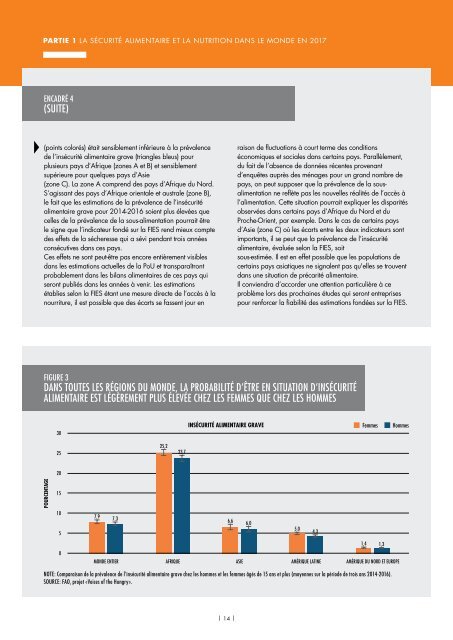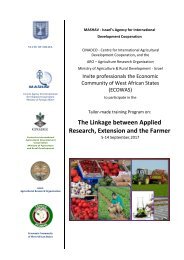L’État de la sécurité alimentaire et de la nutrition dans le monde 2017
L’État de la sécurité alimentaire et de la nutrition dans le monde 2017.
L’État de la sécurité alimentaire et de la nutrition dans le monde 2017.
Create successful ePaper yourself
Turn your PDF publications into a flip-book with our unique Google optimized e-Paper software.
PARTIE 1 LA SÉCURITÉ ALIMENTAIRE ET LA NUTRITION DANS LE MONDE EN <strong>2017</strong><br />
ENCADRÉ 4<br />
(SUITE)<br />
(points colorés) était sensib<strong>le</strong>ment inférieure à <strong>la</strong> préva<strong>le</strong>nce<br />
<strong>de</strong> l’insécurité <strong>alimentaire</strong> grave (triang<strong>le</strong>s b<strong>le</strong>us) pour<br />
plusieurs pays d’Afrique (zones A <strong>et</strong> B) <strong>et</strong> sensib<strong>le</strong>ment<br />
supérieure pour quelques pays d’Asie<br />
(zone C). La zone A comprend <strong>de</strong>s pays d’Afrique du Nord.<br />
S’agissant <strong>de</strong>s pays d’Afrique orienta<strong>le</strong> <strong>et</strong> austra<strong>le</strong> (zone B),<br />
<strong>le</strong> fait que <strong>le</strong>s estimations <strong>de</strong> <strong>la</strong> préva<strong>le</strong>nce <strong>de</strong> l’insécurité<br />
<strong>alimentaire</strong> grave pour 2014-2016 soient plus é<strong>le</strong>vées que<br />
cel<strong>le</strong>s <strong>de</strong> <strong>la</strong> préva<strong>le</strong>nce <strong>de</strong> <strong>la</strong> sous-alimentation pourrait être<br />
<strong>le</strong> signe que l’indicateur fondé sur <strong>la</strong> FIES rend mieux compte<br />
<strong>de</strong>s eff<strong>et</strong>s <strong>de</strong> <strong>la</strong> sécheresse qui a sévi pendant trois années<br />
consécutives <strong>dans</strong> ces pays.<br />
Ces eff<strong>et</strong>s ne sont peut-être pas encore entièrement visib<strong>le</strong>s<br />
<strong>dans</strong> <strong>le</strong>s estimations actuel<strong>le</strong>s <strong>de</strong> <strong>la</strong> PoU <strong>et</strong> transparaîtront<br />
probab<strong>le</strong>ment <strong>dans</strong> <strong>le</strong>s bi<strong>la</strong>ns <strong>alimentaire</strong>s <strong>de</strong> ces pays qui<br />
seront publiés <strong>dans</strong> <strong>le</strong>s années à venir. Les estimations<br />
établies selon <strong>la</strong> FIES étant une mesure directe <strong>de</strong> l’accès à <strong>la</strong><br />
nourriture, il est possib<strong>le</strong> que <strong>de</strong>s écarts se fassent jour en<br />
raison <strong>de</strong> fluctuations à court terme <strong>de</strong>s conditions<br />
économiques <strong>et</strong> socia<strong>le</strong>s <strong>dans</strong> certains pays. Parallè<strong>le</strong>ment,<br />
du fait <strong>de</strong> l’absence <strong>de</strong> données récentes provenant<br />
d’enquêtes auprès <strong>de</strong>s ménages pour un grand nombre <strong>de</strong><br />
pays, on peut supposer que <strong>la</strong> préva<strong>le</strong>nce <strong>de</strong> <strong>la</strong> sousalimentation<br />
ne reflète pas <strong>le</strong>s nouvel<strong>le</strong>s réalités <strong>de</strong> l’accès à<br />
l’alimentation. C<strong>et</strong>te situation pourrait expliquer <strong>le</strong>s disparités<br />
observées <strong>dans</strong> certains pays d’Afrique du Nord <strong>et</strong> du<br />
Proche-Orient, par exemp<strong>le</strong>. Dans <strong>le</strong> cas <strong>de</strong> certains pays<br />
d’Asie (zone C) où <strong>le</strong>s écarts entre <strong>le</strong>s <strong>de</strong>ux indicateurs sont<br />
importants, il se peut que <strong>la</strong> préva<strong>le</strong>nce <strong>de</strong> l’insécurité<br />
<strong>alimentaire</strong>, évaluée selon <strong>la</strong> FIES, soit<br />
sous-estimée. Il est en eff<strong>et</strong> possib<strong>le</strong> que <strong>le</strong>s popu<strong>la</strong>tions <strong>de</strong><br />
certains pays asiatiques ne signa<strong>le</strong>nt pas qu'el<strong>le</strong>s se trouvent<br />
<strong>dans</strong> une situation <strong>de</strong> précarité <strong>alimentaire</strong>.<br />
Il conviendra d’accor<strong>de</strong>r une attention particulière à ce<br />
problème lors <strong>de</strong>s prochaines étu<strong>de</strong>s qui seront entreprises<br />
pour renforcer <strong>la</strong> fiabilité <strong>de</strong>s estimations fondées sur <strong>la</strong> FIES.<br />
FIGURE 3<br />
DANS TOUTES LES RÉGIONS DU MONDE, LA PROBABILITÉ D’ÊTRE EN SITUATION D’INSÉCURITÉ<br />
ALIMENTAIRE EST LÉGÈREMENT PLUS ÉLEVÉE CHEZ LES FEMMES QUE CHEZ LES HOMMES<br />
30<br />
INSÉCURITÉ ALIMENTAIRE GRAVE<br />
Femmes<br />
Hommes<br />
25<br />
25,2<br />
23,7<br />
20<br />
POURCENTAGE<br />
15<br />
10<br />
5<br />
7,9<br />
7,3<br />
6,6<br />
6,0<br />
5,0<br />
4,3<br />
0<br />
1,4 1,3<br />
MONDE ENTIER AFRIQUE ASIE AMÉRIQUE LATINE AMÉRIQUE DU NORD ET EUROPE<br />
NOTE: Comparaison <strong>de</strong> <strong>la</strong> préva<strong>le</strong>nce <strong>de</strong> l’insécurité <strong>alimentaire</strong> grave chez <strong>le</strong>s hommes <strong>et</strong> <strong>le</strong>s femmes âgés <strong>de</strong> 15 ans <strong>et</strong> plus (moyennes sur <strong>la</strong> pério<strong>de</strong> <strong>de</strong> trois ans 2014-2016).<br />
SOURCE: FAO, proj<strong>et</strong> «Voices of the Hungry».<br />
| 14 |




